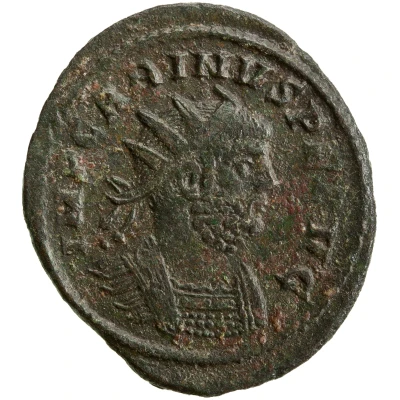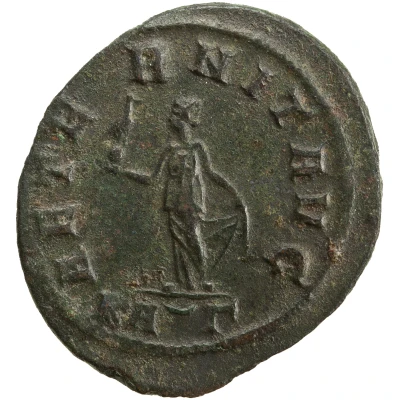


© American Numismatic Society (ANS)
Antoninianus - Carinus Cuirassed; AETERNIT AVG; Aeternitas
| Silver | 3.9 g | 22.5 mm |
| Issuer | Rome › Roman Empire (27 BC - 395 AD) |
|---|---|
| Emperor | Carinus (Marcus Aurelius Carinus) (283-285) Numerian (Marcus Aurelius Numerius Numerianus) (283-284) |
| Type | Standard circulation coin |
| Years | 283-285 |
| Value | Antoninianus (1) |
| Currency | Antoninianus, Reform of Caracalla (AD 215 – 301) |
| Composition | Silver |
| Weight | 3.9 g |
| Diameter | 22.5 mm |
| Shape | Round (irregular) |
| Technique | Hammered |
| Orientation | Variable alignment ↺ |
| Demonetized | Yes |
| Updated | 2024-10-05 |
| Numista | N#298280 |
|---|---|
| Rarity index | 93% |
Reverse
Aeternitas, draped, standing left, holding phoenix on globe in right hand and lifting robe with left hand.
Scripts: Latin, Greek
Lettering: AETERNIT AVG
Unabridged legend: Aeternitas Augusti.
Translation: Eternity of the emperor.
Comment
Mass varies: 3.03–4.881 g;Diameter varies: 21–23.05 mm;
Example of this type:
American Numismatic Society (ANS)
Source:
Online Coins of the Roman Empire (OCRE)
Interesting fact
The Antoninianus coin was issued during the reign of Carinus, who was a Roman emperor from 283 to 285 AD. The coin's design features a cuirassed bust of Carinus on the obverse (front side), and the goddess Aeternitas standing on the reverse (back side). The use of Aeternitas on the coin's reverse was a common feature of coins issued during the late Roman Empire, as she was seen as a symbol of eternity and the enduring nature of the Roman state. It's worth noting that the Antoninianus was a standard circulation coin during the Roman Empire, and it was made of silver. The coin weighs 3.9 grams, which is relatively light compared to other coins issued during the same period. Despite its relatively small size, the Antoninianus was an important coin in the Roman economy, as it was widely used for everyday transactions and was a key component of the Roman monetary system.